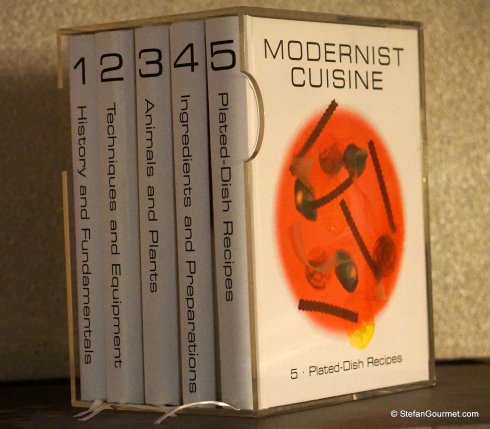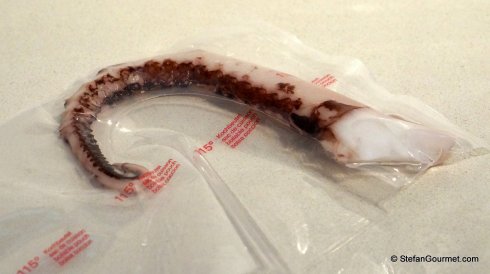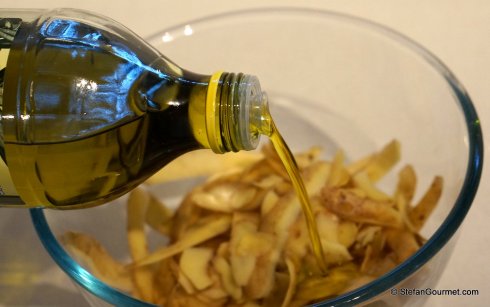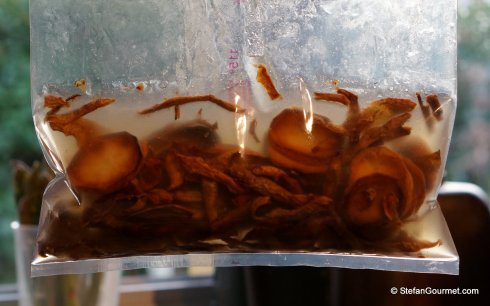“Modernist Cuisine” is an amazing set of books by Nathan Myhrvold and a team. It was supposed to be a single book on sous-vide cooking, but things got a little out of hand and it ended up being a 5-volume standard textbook on a modernist approach to cooking. It actually also covers traditional cooking techniques. I’ve had the books for two years and I still haven’t finished ‘reading’ them completely. When I do, and I intend to, I will write more about them. It is good to know that in the meantime a smaller version called “Modernist Cuisine at Home” has been published, which is probably more suitable for home use. That wasn’t around yet when I got my copy.
The fifth volume contains recipes for plated dishes. These are complex recipes that are fare more suitable for gourmet restaurants than for the home kitchen. Many take multiple days to prepare and fancy equipment like a centrifuge or a pacojet. I’ve used information the Modernist Cuisine books in my cooking from when I got them, but so far I had not ventured into the daunting fifth volume. When Auldo came over to cook, I thought it would be nice to finally try some of the plated dishes. He has quite some experience with complicated modernist dishes, because he’s cooked his way through Heston Blumenthal’s Big Fat Duck Cookbook. We browsed through the recipes and selected two for which we had the equipment and the time (as it was Friday when we did the selection for what to cook between then and Sunday). We selected a ‘shrimp cocktail’ and a modernist take on the Spanish (well, Galician) classic of Pulpo a la Gallega, octopus with potatoes. This post covers the octopus, the shrimp will follow soon.

It became clear pretty quickly that the recipes in the plated dish volume are not very suitable for home cooking. They are written in a modular way that is appropriate for a restaurant kitchen, where each component is prepared in advance by another member of the cooking staff. When preparing all the components in parallel, as we did, it would be much easier to have a description that will tell you what to do when, and to have it all in one place in the book.

Instead, the instructions to make Pulpo a la Gallega are spread out over four of the five volumes! So it is nice to have a lot of space to be able to read them all at the same time.

For example, the main recipe for Pulpo a la Gallega in volume 5 will list “Baked Potato Foam” as one of the ingredients, with the instruction “see page 4-281”.

Then on page 4-281, the ingredients for baked potato foam include baked potato broth, “see pages 2-309 and 3-302”. You can also see here that the ingredients for baked potato foam contain unusual ingredients such as “Iota carrageenan” and “Xanthan gum”. This is typical of most recipes in Modernist Cuisine.
In terms of special equipment, the Pulpo a la Gallega ‘only’ requires sous-vide equipment, a dehydrator, and a whipping siphon. We simplified things by using good quality store-bought chorizo rather than making our own, which was listed as an optional step that would take another 3 days.

This shot includes all the prepped ingredients:
- Black olive oil
- Chorizo crisps
- Frozen chorizo (to grate into powder)
- Sous-vide octopus
- Smoked potato confit
- Baked potato foam (in the whipping siphon)
It also shows the paprika and tarragon that was used as garnish. I will first describe all the prep work and will finish with the final assembly of the dish.
Black olive oil
Dehydrate 150 grams of pitted black olives at 60ºC/140ºF for 12 hours until brittle.
Pour 125 grams of extra virgin olive oil into a blender.
Add the olives.
Blend for 15 minutes…
…until the oil is black.
Pour the black oil into a vacuum pouch…
…and vacuum seal. Allow to macerate at room temperature for 12 hours.
Strain through a fine sieve.
Chorizo crisps
Slice the chorizo 1 mm thick. The book says lengthwise, but that would be very impractical.
Dust evenly with N-Zorbit M and shake off excess. Dehydrate at 45ºC/113ºF until dry and crisp, about 5 hours.
Even after quite a bit longer than that they were not crispy yet, so we crisped them up in a hot oven for a few minutes.
I had never heard of N-Zorbit M, but luckily Auldo had this powder that is used more often as a helper ingredient with the dehydrator.
Sous-vide octopus
I’ve done sous-vide octopus many times before, and I’ve always just vacuum sealed the octopus legs straight away. Modernist Cuisine tells us to blanch the legs for 30 seconds to remove the slime…
…and to cool in an ice water bath. I don’t think I’ve noticed much of a difference between blanching and not blanching, but I should do a side-by-side to make sure. As it is an additional step that doesn’t seem to have added much, I think I will skip the blanching.
Modernist Cuisine says to vacuum seal the octopus legs individually. We vacuum sealed one leg individually and the others together and did not notice any difference.
Cook sous-vide for 4 hours at 85ºC/185ºF.
Peel the skin off of some of the octopus legs.
Vacuum seal peeled legs with olive oil.
Baked potato foam, ingredients
500 grams waxy potatoes
1.25 grams Iota carrageenan
1 gram xanthan gum
125 grams heavy cream
35 grams olive oil
salt
For the baked potato broth
100 grams potato skins
frying oil
75 grams floury potatoes
clarified butter
potato juice
salt
Baked potato foam, preparation
Peel the potatoes and cut them into chunks. Reserve the peels and soak the potatoes in cold water.
Allow the potatoes to soak for 20 minutes to make the potato juice (the book does not describe clearly how to make the potato juice, it only says “decant from starch residue”).
This will yield the potato juice needed to make the potato broth.
Slice the floury potato into thin slices.
Pan-fry those slices in clarified butter.
Fry them over medium heat until deep golden, about 15 minutes per side.
Allow to drain on paper towels.
Meanwhile, combine the potato peels with olive oil.
Dehydrate them in the oven for 7 hours at 95ºC/200ºF until golden and completely desiccated as prescribed by the book, or for an hour at 150ºC/300ºF to save some time.
Allow to cool.
Combine the pan-fried potato slices with the desiccated potato skins and the potato juice…
…and vacuum seal. Cook sous-vide for 1.5 hours at 80ºC/176ºF.
Strain and reserve.

The book says to season the baked potato broth with salt, but it is better to do this later as you do not know yet exactly how much of the baked potato broth you will need to make the foam.
To make potato puree the book says to “simmer until tender”, but since we were cooking potatoes sous-vide for the confit anyway, we decided to cook the potatoes for the puree sous-vide as well (1 hour at 90ºC/194ºF).
Press the potatoes through a fine tamis…
…using a dough scraper…
…to make a very smooth potato puree. Keep this warm.
Disperse the iota carrageenan and xanthan gum into 150 grams of the cold (!) broth.
Heat this mixture to 95ºC/203ºF and hold for 3 minutes to fully hydrate. Remove from the heat.
Blend the olive oil and heavy cream into the warm broth.
Fold in the potato puree.
The mixture should be smooth and have a medium thick consistency. We had to add some more potato broth to make this work. Taste and adjust the seasoning with salt.
Transfer to a 1 litre whipping siphon and charge with two cartridges of nitrous oxide. Shake well.
Hold in a 70ºC/158ºF bath until needed.
Smoked potato confit
Ingredients are potatoes, olive oil, and salt.
Peel the potatoes and vacuum seal them. Cook sous-vide for 1 hour at 90ºC/194ºF.
The book says to first smoke the potatoes and then cut them into a nice shape using a ring mold. I had not read this correctly (I blame the fact that the recipe is spread out and a bit unclear) so I cut them into nice shapes before smoking.
Put the potatoes in a stovetop smoker with 2 Tbsp of smoking dust (Modernist Cuisine says to use oak and nectarine wood).
Hot-smoke for 30 minutes.
The potatoes will obtain a brown color. Although this is not completely clear in the book, I think it was intended to remove this and so we did. Vacuum seal the potatoes with olive oil until needed.
Final assembly
If all went well, you should now have all the components as depicted above. Don’t forget to put the chorizo into the freezer.
The book says to warm the peeled octopus at 60ºC/140ºF for 15 minutes and to heat the siphon with the baked potato foam in 70ºC/158ºF for 15 minutes. Since I ‘only’ have the one water bath, I decided to use 70ºC/140ºF for both. Reheat the smoked potatoes in the same bath for 15 minutes as well.

Brush the unpeeled octopus with oil and grill over charcoal until deeply charred, about 2 minutes. Season with salt.
Sear the potato confit until golden.
Arrange peeled and unpeeled octopus legs on each warm plate with potato confit and chorizo crisps. Dispense baked potato foam.
Grate frozen chorizo with microplane grater over octopus.
Garnish with drizzle of black olive oil, dusting of paprika, and tarragon leaves. We were too hungry and tired to put a lot of effort into the final plating and photographing, so this photo doesn’t really do it justice.
The verdict
This was very good. I’ve already prepared octopus by cooking sous-vide and then grilling before, and that is always delicious. The smoked potato confit was very good and certainly worth repeating. The baked potato foam was good and tastes like potato chips, but perhaps too much work for the end result. The black olive oil looked a bit messy on the plate and didn’t have a very special taste. I’d leave that out. The combination of the octopus, chorizo, potato and paprika worked very well. This was no surprise, as it is a classic combination from Spain.
This was a ridiculous amount of work for a home-cooked dish. It was delicious, a great experience and I’ve certainly learned a few things, but I prefer the classic way of preparing Pulpo a la Gallega (perhaps using sous-vide to cook the octopus) in terms of flavor for effort.
The recipe in the book has some inconsistencies and is sometimes vague. Especially for the baked potato foam the instructions are not sufficient if you are not experienced with similar recipes (luckily I had Auldo around).
Flashback

Two years ago I baked a classic Dutch apple pie (closely related to American apple pie, as that has probably been introduced by Dutch immigrants) for my birthday. This is a recipe I’ve made for 15 years and it’s so good I’ve never seen much reason to change it.



















































You’re correct – it is a lot of work for the home cook! However, the octopus looks really good and I can already see applications for the black olive oil.
LikeLike
Have you ever prepared something like this?
LikeLike
I’ve grilled octopus before – my preferred method of cooking rather than stewing. But, since I am most familiar with Greek cooking, I simply marinate it in good green olive oil, lemon juice, oregano, garlic and sometimes hot pepper flakes – the standard “souvlaki” marinade. The black olive oil is something new, but reminds me of tapanade which I love.
LikeLike
Will it be tender if you just marinate and grill it?
LikeLike
Well, the Greeks beat octopus when it is freshly caught to tenderise it. I assume that store bought octopus has been treated this way first. And, yes, the citric acid of the lemon works as a further tenderiser while the oil provides moisture. Besides, I quite like the slight chewy texture of octopus and squid – though not as tough as rubber.
LikeLike
I was wondering, because I always cook it sous-vide first. This makes it tender although it still is recognizable as octopus. (Even if you don’t have sous-vide equipment, you could still cook it sous-vide if you wanted in a stock pot using a ziploc bag, as the temperature at which to cook octopus sous-vide is not very critical.)
The usual way to tenderize store-bought octopus is that it has been frozen.
LikeLike
I’ll give the method a try!
LikeLike
Shew! That looks exhausting! A great learning experience but I imagine it took so long, you must have been starving by the time you were done! Love the tutorial though! And the flavor combo!
LikeLike
Thanks, it was indeed quite an undertaking.
Like your new avatar pic by the way!
LikeLike
Thanks you sir! You are the first person to comment on it. I liked the other photo better but for sentimental reasons. This photo is a much better avatar.
LikeLike
Amazing dish and the baked potato foam is incredible. I really like the Black Olive oil though … would canned olives work okay?
LikeLike
This is lovely! You guys did fantastic. I love my Modernist Cuisine books and the at Home version (btw, they have an e-book version of the At Home book at inkling.com and it is fantastic. Much more than a plain old e-book). Of course you hang out with Auldo :-). His blog was on my regular reading list and is still a reference for me when I try to cook something from Fat Duck.
Regarding these insanely complex recipes, I agree that they are not for the everyday home cook, but I like to do one every so often just to learn a few techniques and I do enjoy the immense amount of organization and preciseness that goes into it. They are great to home ones skills. I just finished a recipe from Alinea that took over 3 weeks to complete and will be posting about it soon. These recipes from the masters are usually very much worth the effort.
LikeLike
Only in Stefan’s kitchen!
LikeLike
vedo che usi molto la cottura sottovuoto; dovrò provare anch’io. Bella la tua ricetta
LikeLike
I admire your dedication to the craft Stefan. This is more alchemy than home cooking that’s for sure. I think I’d have lost interest in eating the food after all the special ingredients, equipment and time put into this preparation. Following on from previous comments, I have never prepared “tough” calamari or octopus and I buy it fresh, not frozen. Both need to be peeled, then both either cooked very very quickly or for more than 20 minutes. Kiwi fruit and green papaya both contain an enzyme that is a natural tenderiser and the cephalopods can be marinated in a purée for 12-24 hours, guaranteed tenderness. The puréed fruit can be washed off and strangely no flavour is absorbed
LikeLike
“Modernist Cuisine” sounds like an excellent set. I will have to see if it is available here. You are a Cooking Gladiator, Stefan; WOW. The pulpo a la gallega looks perfect and scrumptious. I am glad to hear you had a lovely birthday weekend with TWO excellent dinners, shared with good friends/family and prepared by the best chef in The Netherlands! 🙂 Best, Shanna
LikeLike
Gargantuan effort Stefan. I would have given up at sieving the black olive oil.
Beautiful end result.
LikeLike
Thanks Conor. It was also a gargantuan effort to sort out the photos and write the post. I’m saving the other recipe for another rainy Sunday
LikeLike
Wow! Seriously interesting cooking – and what a lot of work! I’ve got the Modernist at Home book and am thoroughly enjoying trying things out – not got the siphon yet but I do now have a pressure cooker which is fun! I like the idea of some of these pieces – the frozen chorizo for example, and the confit smoked potatoes – and might give them a go. A great post also – super photos and descriptions – thanks so much for sharing this
LikeLike
Hi there, this whole recipe, give or take, how many portion do you recon it can serve??
LikeLike
The recipes in the book are all for 4 servings, but the amount for some of the components is larger.
LikeLike
thank you SO much for this and other posts!
Question re: cook time. Here you cook the octopus for 4 hours. In the other sous vide octopus recipe, you do 3 hours. Is there a reason for the difference? Same temperature both times, and I think grilled briefly both times as well apres-vide.
Dankjewel en prettige kerstdagen 🙂 🎄
LikeLiked by 1 person
The reason is that there are different recommendations out there. I’ve actually done an experiment to compare different time and temperature combinations for octopus that you might like: https://stefangourmet.com/2020/05/23/octopus-sous-vide-time-and-temperature/
LikeLike